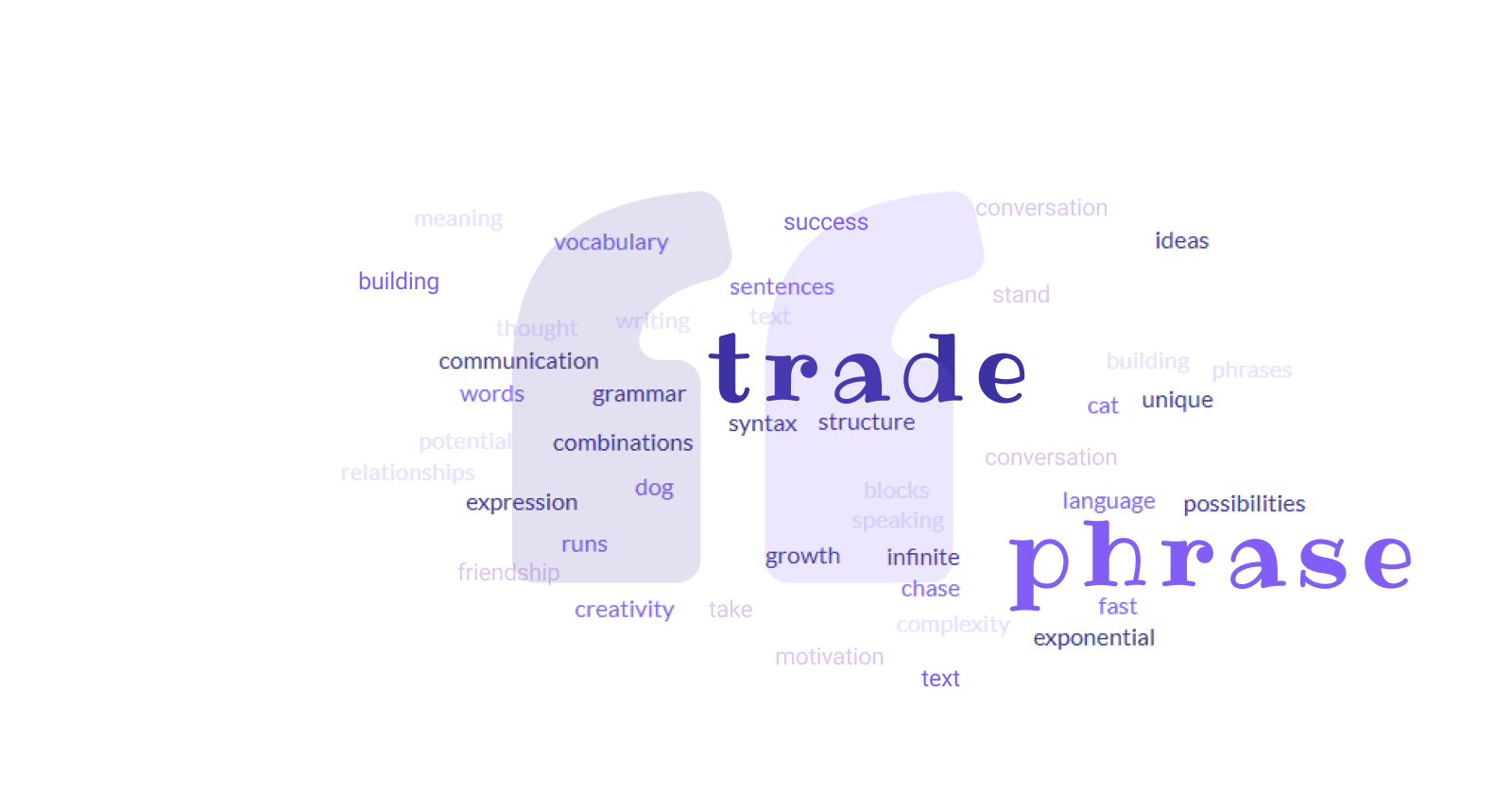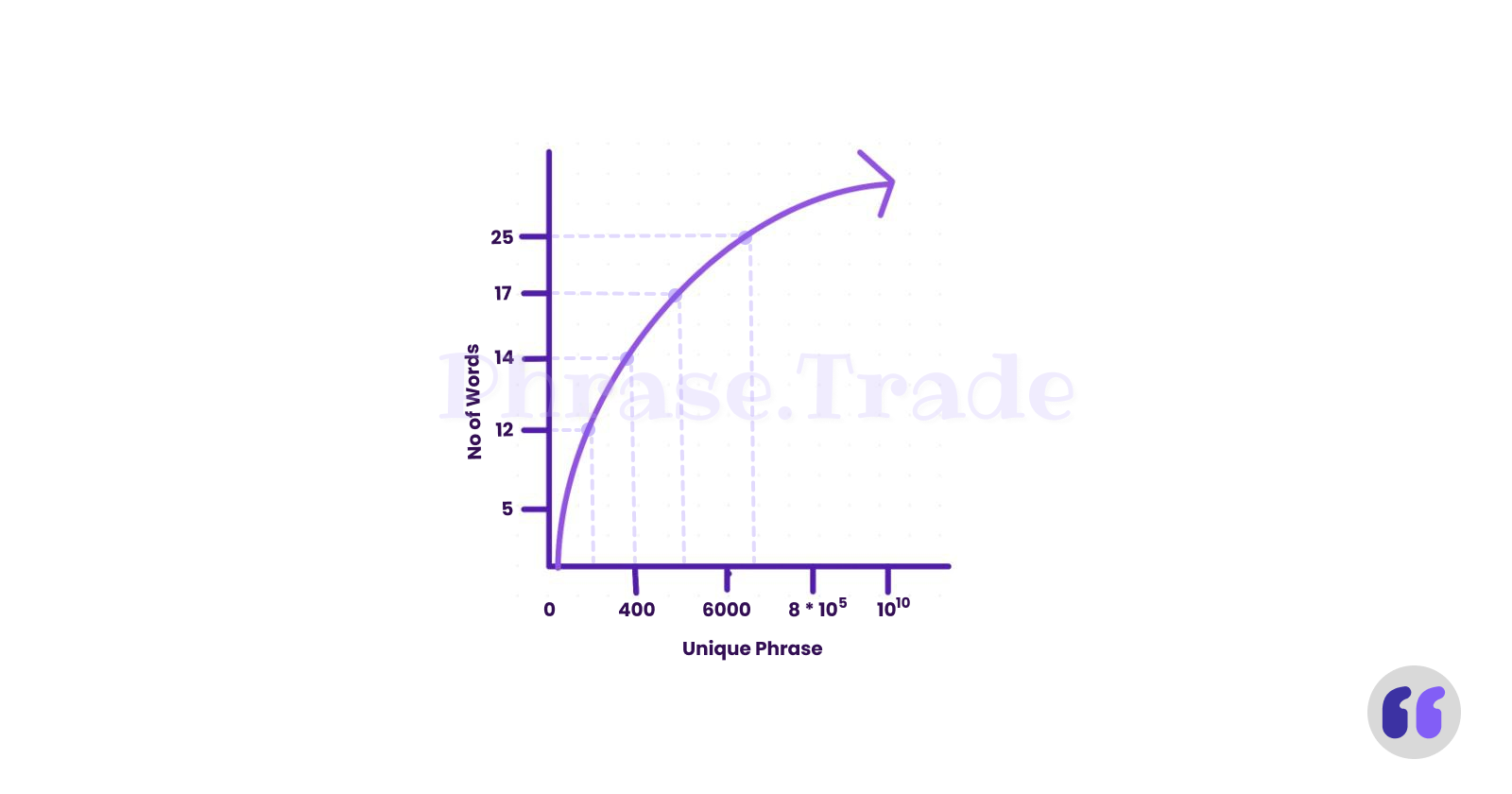How the Number of Words Affects the Number of Unique Phrases: An Exponential Growth
 Phrase Trade Protocol
Phrase Trade ProtocolTable of contents

In the world of language, words are building blocks, and sentences are the structures we create with them. But how does the number of words relate to the number of unique sentences we can form? The answer lies in an exponential relationship that shows how even a small increase in vocabulary can lead to a dramatic explosion in the number of possible sentences. This blog post explores this fascinating relationship between words and unique phrases.
The Basics: Words as Building Blocks
Let's start with a simple example. Imagine you have just two words: "cat" and "runs." With these two words, you can form a couple of basic sentences:
"The cat runs."
"Runs the cat."
Even with just two words, you can vary the order and structure slightly to form unique sentences. However, the possibilities are quite limited.
Adding More Words: The Growth Begins
Now, let’s add more words to the mix. Suppose you have five words: "cat," "runs," "dog," "chases," and "fast." Suddenly, your options expand dramatically. You can form sentences like:
"The cat runs fast."
"The dog chases the cat."
"Fast runs the dog."
With these additional words, the number of unique sentences increases rapidly. Instead of just a few options, you can now create around 10 different sentences.
The Exponential Nature of Language
The real magic happens when you continue adding words. Each new word can be combined with all the previous words in countless ways, creating a combinatorial explosion. This is where the relationship between the number of words and unique sentences becomes exponential.
For instance:
10 Words → 80 Sentences: If you have 10 words, you can form around 80 unique sentences. The possibilities are expanding quickly, but this is just the beginning.
15 Words → 1,000 Sentences: With 15 words, you suddenly have around 1,000 unique sentences. The growth is no longer linear—it's starting to skyrocket.
20 Words → 10,000 Sentences: By the time you have 20 words in your vocabulary, you can create approximately 10,000 unique sentences. The increase in complexity is dramatic, and it highlights the power of language to convey infinite ideas with a relatively small number of words.
Why Does This Happen? The Power of Combinations
The exponential growth in unique sentences occurs because of the combinatorial nature of language. Each new word you add can be combined with all the previous words in various ways. For example, if you have 10 words, you might arrange them in different sequences, use them in different grammatical roles (e.g., subject, verb, object), and vary the sentence length.
Here’s a simplified mathematical explanation: If you have ( n ) words, the number of unique sentences can be thought of as proportional to ( C^n ), where ( C ) is a constant that represents the average number of ways words can be arranged in a sentence. This leads to exponential growth as ( n ) increases.

Few Words, Few Sentences: When you have only a few words, the number of possible unique sentences is limited. For example, with just 2 words, you can form a small number of sentences by varying the order of the words or adding basic structure.
Increasing Words, Exploding Sentences: As the number of words increases, the number of potential unique sentences increases dramatically. This is because each new word can be combined in various ways with all the previously available words, leading to an exponential explosion in sentence possibilities.
Exponential Growth:
Mathematically: If you have n words, the potential number of unique sentences can be estimated as something like (C^n), where C is a constant that depends on the grammatical structure (e.g., sentence length, syntax rules). In simpler terms, it's similar to a combinatorial explosion, where each new word dramatically increases the number of possible combinations.
Graph Idea:
The x-axis represents the number of words.
The y-axis represents the number of unique sentences.
The graph would start off relatively flat (with few words, few sentences), but as you add more words, the graph would steeply rise, reflecting the exponential increase in the number of possible unique sentences.
Visual Representation:
Low Words: At the beginning, the graph would rise slowly.
As Words Increase: As you move to the right on the x-axis (increasing words), the y-axis (unique sentences) would rise dramatically, creating a sharp exponential curve.
Real-World Implications: Language and Creativity
This exponential relationship between words and unique sentences has profound implications for creativity, communication, and even artificial intelligence. In human communication, it explains why language is so powerful: A relatively small vocabulary can express an enormous range of ideas, emotions, and concepts.
In fields like AI and natural language processing (NLP), understanding this relationship helps in designing systems that can generate or understand human-like sentences. As AI models grow more sophisticated, they leverage this combinatorial power to create more nuanced and contextually appropriate responses.
Conclusion: The Infinite Possibilities of Language
The relationship between the number of words and the number of unique sentences illustrates the vast potential of language. With just a small increase in vocabulary, the possibilities for expression multiply exponentially, allowing for a seemingly infinite number of unique sentences. This is what makes language so powerful it can convey endless ideas with a limited set of building blocks.
Whether you're a writer, a speaker, or someone working in the field of AI, understanding this exponential relationship can inspire you to harness the full potential of language. Every word added to your vocabulary is not just another building block; it's a gateway to a vast universe of unique sentences, ideas, and expressions.
So, the next time you learn a new word, remember: You're not just expanding your vocabulary you're unlocking countless new possibilities for communication.
Subscribe to my newsletter
Read articles from Phrase Trade Protocol directly inside your inbox. Subscribe to the newsletter, and don't miss out.
Written by

Phrase Trade Protocol
Phrase Trade Protocol
Explore Phrase.Trade Protocol to mint unique, customizable text NFTs. Create, collect, and trade phrases securely on the blockchain. Join the community today!